The COP9 signalosome regulates the Neurospora circadian clock by controlling the stability of the SCFFWD-1 complex
- PMID: 15961524
- PMCID: PMC1172059
- DOI: 10.1101/gad.1322205
The COP9 signalosome regulates the Neurospora circadian clock by controlling the stability of the SCFFWD-1 complex
Abstract
The COP9 signalosome (CSN) promotes the function of SCF-type cullin-based ubiquitin ligase complexes in vivo. Paradoxically, removal of the Nedd8 modification of cullins by CSN inhibits the ubiquitin ligase activity of SCF complexes in vitro. Ubiquitination-mediated degradation of the Neurospora circadian clock protein FREQUENCY (FRQ) is critical for clock function. Ubiquitination of FRQ requires FWD-1, the substrate-recruiting subunit of an SCF complex. Here we show that disruption of a subunit of CSN (csn-2) impairs the degradation of FRQ and compromises its normal circadian expression. A FRQ-independent oscillator drives conidiation in the csn-2 mutant, resulting in a 2-d conidiation rhythm that persists in constant darkness (DD), constant light (LL), light-to-dark (LD) transitions, and temperature cycles. Strikingly, the levels of FWD-1 are drastically reduced in csn-2 mutant, explaining the impaired degradation of FRQ. Reduction of FWD-1 levels in the mutant requires its F-box, suggesting that its degradation is due to autoubiquitination. In addition, SKP-1 and CUL-1 of the SCF(FWD-1) complex are also unstable in the mutant. Therefore, our results establish an important role of CSN in the circadian clock of Neurospora. Our findings also reconcile the CSN paradox and suggest that a major function of CSN is to maintain the stability of SCF ubiquitin ligases in vivo.
Figures

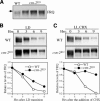
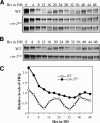
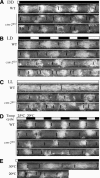
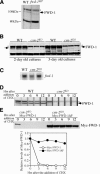
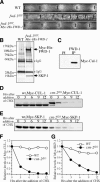
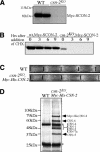
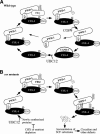
Similar articles
-
Degradation of the Neurospora circadian clock protein FREQUENCY through the ubiquitin-proteasome pathway.Biochem Soc Trans. 2005 Nov;33(Pt 5):953-6. doi: 10.1042/BST20050953. Biochem Soc Trans. 2005. PMID: 16246019
-
Neurospora COP9 signalosome integrity plays major roles for hyphal growth, conidial development, and circadian function.PLoS Genet. 2012;8(5):e1002712. doi: 10.1371/journal.pgen.1002712. Epub 2012 May 10. PLoS Genet. 2012. PMID: 22589747 Free PMC article.
-
Role of individual subunits of the Neurospora crassa CSN complex in regulation of deneddylation and stability of cullin proteins.PLoS Genet. 2010 Dec 2;6(12):e1001232. doi: 10.1371/journal.pgen.1001232. PLoS Genet. 2010. PMID: 21151958 Free PMC article.
-
Mammalian COP9 signalosome.Genes Cells. 2009 Nov;14(11):1209-25. doi: 10.1111/j.1365-2443.2009.01349.x. Epub 2009 Oct 22. Genes Cells. 2009. PMID: 19849719 Review.
-
COP9 signalosome: a multifunctional regulator of SCF and other cullin-based ubiquitin ligases.Cell. 2003 Sep 19;114(6):663-71. doi: 10.1016/s0092-8674(03)00722-0. Cell. 2003. PMID: 14505567 Review.
Cited by
-
Methylation of histone H3 on lysine 4 by the lysine methyltransferase SET1 protein is needed for normal clock gene expression.J Biol Chem. 2013 Mar 22;288(12):8380-8390. doi: 10.1074/jbc.M112.359935. Epub 2013 Jan 14. J Biol Chem. 2013. PMID: 23319591 Free PMC article.
-
C. elegans CAND-1 regulates cullin neddylation, cell proliferation and morphogenesis in specific tissues.Dev Biol. 2010 Oct 1;346(1):113-26. doi: 10.1016/j.ydbio.2010.07.020. Epub 2010 Jul 24. Dev Biol. 2010. PMID: 20659444 Free PMC article.
-
Functional significance of FRH in regulating the phosphorylation and stability of Neurospora circadian clock protein FRQ.J Biol Chem. 2010 Apr 9;285(15):11508-15. doi: 10.1074/jbc.M109.071688. Epub 2010 Feb 16. J Biol Chem. 2010. PMID: 20159972 Free PMC article.
-
Circadian rhythms in Neurospora crassa: clock mutant effects in the absence of a frq-based oscillator.Genetics. 2007 Mar;175(3):1175-83. doi: 10.1534/genetics.106.068270. Epub 2007 Jan 21. Genetics. 2007. PMID: 17237512 Free PMC article.
-
Light regulates the degradation of the regulatory protein VE-1 in the fungus Neurospora crassa.BMC Biol. 2022 Jun 27;20(1):149. doi: 10.1186/s12915-022-01351-x. BMC Biol. 2022. PMID: 35761233 Free PMC article.
References
-
- Akten B., Jauch, E., Genova, G.K., Kim, E.Y., Edery, I., Raabe, T., and Jackson, F.R. 2003. A role for CK2 in the Drosophila circadian oscillator. Nat. Neurosci. 6: 251–257. - PubMed
-
- Aronson B., Johnson, K., Loros, J.J., and Dunlap, J.C. 1994a. Negative feedback defining a circadian clock: Autoregulation in the clock gene frequency. Science 263: 1578–1584. - PubMed
-
- Busch S., Eckert, S.E., Krappmann, S., and Braus, G.H. 2003. The COP9 signalosome is an essential regulator of development in the filamentous fungus Aspergillus nidulans. Mol. Microbiol. 49: 717–730. - PubMed
Publication types
MeSH terms
Substances
Grants and funding
LinkOut - more resources
Full Text Sources
Other Literature Sources
Research Materials
Miscellaneous
